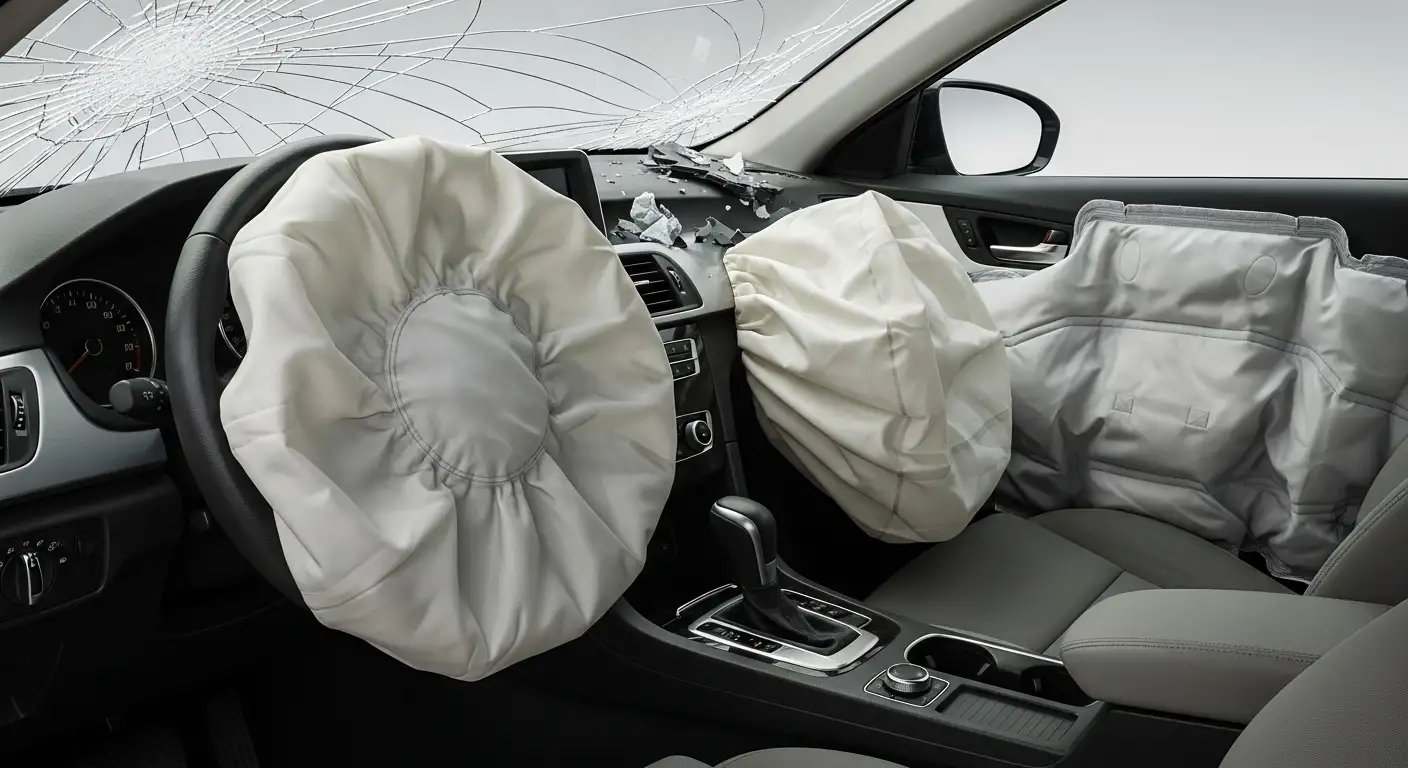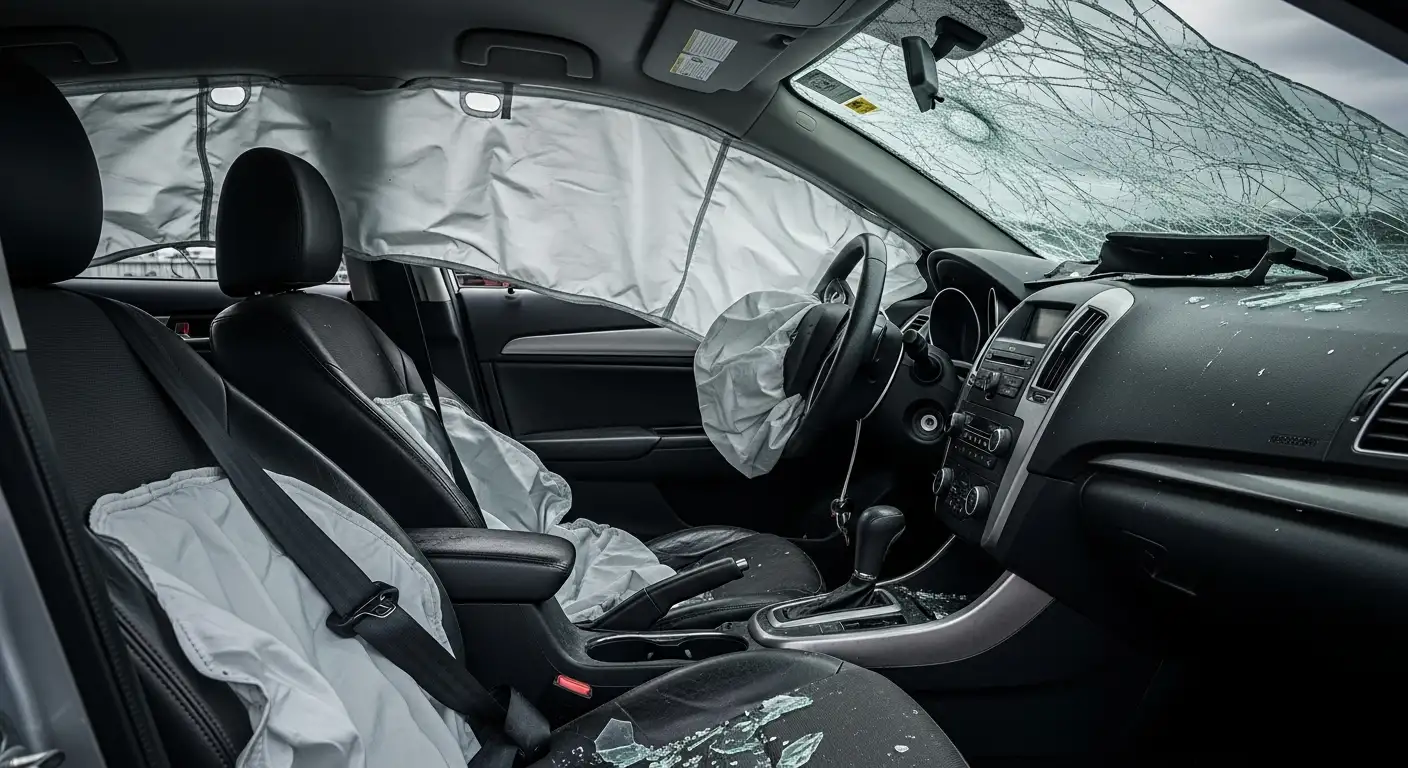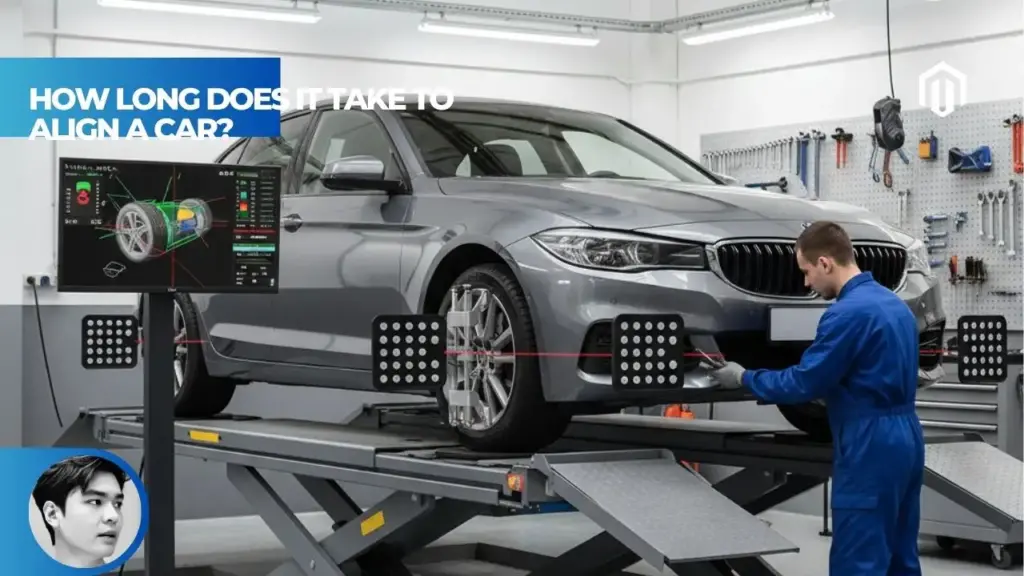You may also like:
- 【Explained】What Happens When Your Car Is Totaled But Still Drivable?
- 【Explained】How Much Is It to Fix a Car Bumper? Full Cost Breakdown by Damage Type
- 【Explained】How Much Does It Cost to Epoxy 2 Car Garage?
- 【Explained】How Many Miles Is Good for a Used Car? (Why Maintenance Matters More)
- 【Explained】When Does the 2-Hour Car Seat Rule End for Babies?
No, a car is not automatically totaled just because the airbags deploy, but the high replacement costs of $3,000-$10,000+ often push the total repair bill above the insurance threshold of 70-80% of the car’s actual cash value. This makes total loss extremely likely, especially for older or lower-value vehicles where airbag replacement alone can exceed the car’s worth.

Does Airbag Deployment Automatically Total a Car
The common misconception that airbag deployment automatically totals a car stems from the frequency with which deployed airbags lead to total loss declarations. However, the deployment itself doesn’t determine total loss status—it’s the cumulative repair costs that matter.
Is a Car Always Totaled If Airbags Deploy
No, airbag deployment doesn’t guarantee your car will be totaled. Insurance companies use specific formulas comparing repair costs to vehicle value, not the presence or absence of deployed airbags. According to industry data, approximately 70% of vehicles with deployed airbags end up being totaled, but 30% are successfully repaired and returned to service[1].
The determining factors include:
- Total repair costs including bodywork
- Vehicle’s pre-accident value
- State-specific total loss thresholds
- Hidden structural damage discovered during inspection
Modern vehicles with higher values often survive airbag deployment financially. A 2025 BMW X5 worth $70,000 can absorb $10,000 in airbag replacement costs without approaching total loss territory.
My Airbags Deployed, Is My Car a Write-Off
Your car becomes a write-off only when repair costs exceed your state’s total loss threshold. Most states set this between 70-80% of actual cash value (ACV), meaning a $15,000 car becomes totaled when repairs exceed $10,500-12,000[2]. Airbag deployment often pushes repairs into this range but doesn’t guarantee it.
Real-world example: A 2020 Honda Accord worth $22,000 experiences front-end collision with both front airbags deploying. Repair estimate totals $14,000 including:
- Airbag replacement: $4,500
- Front bumper and hood: $3,500
- Radiator and AC condenser: $2,000
- Paint and labor: $4,000
At 63% of value, this vehicle gets repaired despite airbag deployment.
Airbag Deployed but Car Looks Fine
Minimal visible damage with deployed airbags creates a frustrating scenario for owners. Airbags can deploy at speeds as low as 12-18 mph in frontal crashes, depending on impact angle and sensor readings[3]. Your car might look virtually undamaged while facing thousands in hidden costs.
This situation commonly occurs with:
- Undercarriage impacts triggering sensors
- Angular collisions concentrating force
- Impacts with rigid objects like poles
- Multiple minor impacts in rapid succession
Even without visible damage, mandatory replacements after deployment include airbags, sensors, control module, and seatbelts—easily totaling $5,000+.
Likelihood of Car Being Totaled After Airbag Deployment
Statistical analysis reveals clear patterns in total loss probability following airbag deployment, varying significantly by vehicle age and value.
Vehicle age dramatically impacts outcomes:
- 0-3 years old: 35% totaled
- 4-7 years old: 65% totaled
- 8+ years old: 85% totaled
These percentages reflect depreciation’s impact on the repair-to-value ratio.
Car Totaled for Minor Damage and Airbags
Insurance companies frequently total cars with minor body damage when airbags deploy, particularly on vehicles worth under $15,000. The math becomes unavoidable: $5,000 minimum for airbag system replacement plus even $3,000 in body repairs exceeds 70% of a $12,000 car’s value.
Autvex experts note this creates particular hardship for owners of reliable older vehicles. A well-maintained 2015 Toyota Camry worth $10,000 might run perfectly for years more, yet becomes economically totaled from a minor accident triggering airbag deployment.
How Much Does It Cost to Replace Airbags
Understanding the true cost of airbag replacement reveals why deployment so often leads to total loss. These costs extend far beyond the airbag modules themselves.
Individual Airbag Replacement Costs
Modern vehicles contain multiple airbags, each carrying substantial replacement costs. Labor adds $500-1,000 to parts costs due to complexity and safety requirements[4].
Cost to Replace Driver Side Airbag
Driver-side airbag replacement typically costs $1,000-$2,000 including parts and labor. The steering wheel airbag proves most straightforward to replace, though it still requires:
- New airbag module ($600-1,200)
- Steering wheel removal and reinstallation
- System recalibration
- Diagnostic clearing
Luxury vehicles like Audi models can push costs to $3,000 for driver airbags with integrated controls and heating elements.
Cost to Replace Passenger Side Airbag
Passenger airbag replacement runs $1,500-$2,500, higher than driver-side due to dashboard integration. The entire dashboard often requires removal, adding labor hours. Some vehicles need dashboard replacement if the airbag tears the covering, adding $1,000-2,000 to costs.
Specific cost factors:
- Airbag module: $800-1,500
- Dashboard repair/replacement: $500-2,000
- Labor (3-5 hours): $300-500
- Recalibration: $100-200
Cost to Replace Curtain Airbags
Side curtain airbags cost $1,200-$2,000 per side to replace. These roof-mounted airbags protect occupants in rollovers and side impacts. Replacement requires headliner removal and careful routing of new modules.
Multiple curtain deployments quickly escalate costs:
- Single side: $1,200-2,000
- Both sides: $2,400-4,000
- With B-pillar damage: Add $1,500-3,000
Additional Component Replacement Costs
The true financial impact of airbag deployment extends to numerous supporting components that must be replaced regardless of visible damage.
Cost to Replace Dashboard After Airbag Deployment
Dashboard replacement costs $1,500-$4,000 depending on vehicle complexity. Passenger airbag deployment often cracks or tears the dashboard beyond repair. Luxury vehicles with integrated displays, wood trim, or leather covering push costs higher.
Budget breakdown:
- Economy cars: $1,500-2,000
- Mainstream vehicles: $2,000-3,000
- Luxury vehicles: $3,000-5,000
- With integrated technology: Add $500-1,500
Cost to Replace Airbag Control Module (SRS Module)
The SRS (Supplemental Restraint System) control module requires replacement after deployment, costing $400-$1,200. This computer stores crash data and can’t be reset after deployment. Some specialists offer module reset services for $50-250, though many insurers require full replacement[5].
Component costs:
- Module unit: $300-800
- Programming: $100-200
- Installation: $100-200
- Diagnostic verification: $50-100
Cost to Replace Airbag Sensors
Impact sensors throughout the vehicle cost $50-$300 each to replace. Modern cars have 4-8 sensors that may require replacement after deployment. Front impact sensors often sustain damage in crashes, necessitating replacement regardless of deployment.
Sensor replacement costs:
- Front impact sensors (2): $200-600
- Side impact sensors (2-4): $200-800
- Seat occupancy sensors: $150-400 each
- Total sensor replacement: $600-1,800
Cost to Replace Seat Belts
Seatbelts contain pyrotechnic pretensioners that activate during crashes, requiring replacement at $200-$500 per belt. This often-overlooked cost affects all occupied seating positions during the accident.
Seatbelt replacement breakdown:
- Front seatbelts: $300-500 each
- Rear seatbelts: $200-400 each
- With integrated airbags: Add $200-400
- Total for all positions: $800-2,000
How Insurance Companies Decide to Total a Car
Insurance companies follow strict formulas when determining total loss, removing emotion from financially significant decisions.
What Does a ‘Total Loss’ Mean
Total loss occurs when repair costs exceed a predetermined percentage of the vehicle’s actual cash value. This protects insurers from paying more to repair a car than it’s worth. The declaration triggers specific insurance procedures, claim payments, and title changes.
Total loss involves three key calculations:
- Actual Cash Value (ACV): Current market value
- Repair costs: All necessary repairs to pre-accident condition
- Salvage value: What the damaged car is worth
Repair Cost vs. Actual Cash Value (ACV)
Insurance adjusters compare detailed repair estimates against the car’s ACV using industry databases like KBB and NADA. The ACV reflects what you could sell the car for immediately before the accident, not replacement cost or original purchase price.
| Vehicle Age | Average Depreciation | ACV Impact |
|---|---|---|
| Year 1 | 20-30% | Significant drop |
| Years 2-5 | 15-20% annually | Steady decline |
| Years 6-10 | 10-15% annually | Slower depreciation |
| 10+ years | 5-10% annually | Minimal change |
This depreciation means a car purchased for $35,000 might have an ACV of just $15,000 after five years, making airbag deployment particularly threatening to total loss.
Total Loss Threshold by State
Each state sets different thresholds determining when insurers must total vehicles. These range from 60% in Oklahoma to 100% in Colorado and Texas[2].
Common state thresholds:
- 70%: Arkansas, Indiana, Iowa, Wisconsin
- 75%: Most common (20+ states)
- 80%: Florida, Missouri, Oregon
- 100%: Colorado, Texas
Some states use Total Loss Formula (TLF): When repair costs plus salvage value exceed ACV, the car is totaled.
Car Value vs. Airbag Replacement Cost
The relationship between car value and airbag costs creates a sliding scale of total loss probability. Analysis of 2025 market data reveals critical value thresholds:
High Risk (>80% chance of total loss):
- Cars valued under $8,000
- Vehicles over 10 years old
- High-mileage vehicles (150,000+ miles)
Moderate Risk (40-60% chance):
- Cars valued $12,000-20,000
- 5-8 year old vehicles
- Average mileage for age
Low Risk (<30% chance):
- Cars valued over $25,000
- Less than 4 years old
- Low mileage
Airbag Deployment on an Old Car
Older vehicles face near-certain total loss when airbags deploy. A 15-year-old car worth $5,000 can’t economically support $5,000+ in airbag replacement. Insurance data shows 92% of vehicles over 10 years old with deployed airbags are totaled[6].
This creates difficult decisions for owners of reliable older vehicles. Many choose to keep driving mechanically sound cars despite total loss declaration, though this requires careful consideration of legal and safety implications.

Can a Car Be Fixed If the Airbags Deploy
Technical feasibility differs from economic viability when considering airbag replacement after deployment.
Repairing a Car After Airbag Deployment
Physically, any car with deployed airbags can be repaired if parts are available. The process involves complete replacement of deployed components—airbags can’t be reused or repacked. Professional shops follow strict procedures ensuring proper function of replacement systems.
Repair requirements include:
- OEM or certified replacement parts
- Trained technician installation
- System recalibration
- Diagnostic verification
- Test documentation
Replacing Airbags in a Car
The replacement process requires 4-8 hours for standard dual front airbags, extending to 12+ hours for multiple deployments. Technicians must:
- Disconnect battery and wait 30 minutes
- Remove deployed airbag modules
- Inspect mounting points for damage
- Install new modules with fresh bolts
- Replace all related components
- Reconnect and initialize system
- Clear fault codes
- Perform functional tests
Only certified technicians should attempt airbag replacement due to explosive charges in undeployed units.
Is It Safe to Drive a Car After Airbags Are Replaced
Properly replaced airbags restore full safety function, meeting original manufacturer specifications. However, quality varies significantly between repair facilities. NHTSA reports show properly repaired airbag systems perform identically to original equipment in subsequent crashes[7].
Safety verification checklist:
- ✓ No airbag warning lights
- ✓ Diagnostic scan shows ready status
- ✓ Installation by certified technician
- ✓ OEM or certified parts used
- ✓ All sensors replaced if damaged
- ✓ Documentation of work performed
Is It Worth Fixing a Car After Airbags Have Deployed
The decision to repair involves financial, practical, and emotional factors beyond simple mathematics.
Financial considerations:
- Repair costs vs. car payment for replacement
- Insurance premium changes
- Diminished value after repair
- Potential reliability issues
Autvex analysis suggests repair makes sense when:
- Vehicle is less than 5 years old
- Repair costs stay under 60% of value
- No structural damage exists
- Owner plans to keep car long-term
Airbag Light on After Repair
Persistent airbag warning lights after replacement indicate improper installation or component failure. This serious safety issue requires immediate attention. Common causes include:
- Incorrect installation procedures
- Incompatible aftermarket parts
- Uncleared fault codes
- Damaged wiring harnesses
- Failed clock spring
- Seat sensor malfunction
Never ignore illuminated airbag lights—the system won’t function in a crash.
What Happens When a Car Is Totaled
Understanding the total loss process helps owners navigate insurance claims and replacement decisions.
Salvage Title vs. Rebuilt Title
These title brands permanently affect a vehicle’s value and insurability:
Salvage Title: Issued when insurance declares total loss. Vehicle cannot be driven, sold, or insured until repaired and inspected. Reduces value by 50-70% permanently.
Rebuilt Title: Issued after salvage vehicle passes state inspection. Can be registered and insured but retains stigma. Insurance costs increase 20-40%, and financing proves difficult.
Title progression:
- Clean title → Accident occurs
- Total loss declaration → Salvage title
- Professional repairs → State inspection
- Inspection passed → Rebuilt title
What Happens If My Airbags Deployed but the Car Is Still Drivable
Drivability doesn’t determine total loss status—repair costs do. Many totaled vehicles remain mechanically sound, creating complex decisions for owners. Driving without functioning airbags poses serious safety risks and may violate state laws.
Options for drivable totaled vehicles:
- Accept settlement: Insurance pays ACV minus deductible
- Owner retention: Keep car with salvage title (reduced payout)
- Dispute valuation: Challenge ACV if undervalued
- Buy back: Purchase from insurance after settlement
Insurance typically reduces payout by 20-40% if you keep the vehicle[8].
Special Circumstances and Considerations
Certain scenarios create exceptions to standard total loss calculations.
My Airbags Deployed in a Minor Accident, Will It Be Totaled
Minor accidents with airbag deployment create the most frustrating scenarios. Low-speed impacts (15-20 mph) can trigger deployment while causing minimal body damage. Whether it’s totaled depends entirely on vehicle value versus mandatory replacement costs.
A 2018 Audi A4 worth $25,000 likely survives $7,000 in airbag replacement from a minor accident. The same accident totals a 2010 Honda Civic worth $8,000.
Factors affecting minor accident outcomes:
- Impact angle and location
- Number of airbags deployed
- Hidden sensor damage
- Pre-existing vehicle condition
- State total loss threshold
Will My Car Get a Salvage Title If the Airbags Deployed
Airbag deployment alone doesn’t trigger salvage title—only total loss declaration does. If repair costs stay below threshold, your car retains its clean title despite airbag replacement. However, accident history affects resale value regardless of title status.
Title remains clean when:
- Repairs cost less than total loss threshold
- Insurance covers repairs without totaling
- Owner pays for repairs privately
- Damage falls below reporting requirements
Does Car Insurance Cover Airbag Replacement
Comprehensive and collision coverage typically covers airbag replacement after covered accidents. Coverage depends on:
Collision Coverage: Covers airbag replacement from accidents you cause
Comprehensive Coverage: Covers deployment from theft, vandalism, or acts of nature
Liability Only: Provides no coverage for your vehicle’s airbags
Important coverage details:
- Deductibles apply ($500-1,000 typical)
- Coverage limits must exceed repair costs
- Some policies exclude modified vehicles
- Aftermarket parts may be specified
Without proper coverage, owners face paying thousands out-of-pocket or accepting total loss with no compensation.

Key Takeaways
- Airbag deployment doesn’t automatically total a car – it’s the repair cost versus value that matters
- Replacement costs range $3,000-$10,000+ including all required components and labor
- 70-80% of vehicle value triggers total loss in most states
- Older cars face 85%+ probability of total loss with deployed airbags
- Hidden costs include dashboard, sensors, seatbelts, and control modules beyond airbags
- Salvage titles permanently reduce value by 50-70% even after proper repairs
- Comprehensive or collision coverage required for insurance to cover replacement costs
Next Steps
First, obtain a comprehensive damage assessment from a certified shop, not just a visual inspection. Request detailed estimates breaking down airbag replacement, associated components, and any structural repairs. Compare this total against your car’s actual cash value using KBB, Edmunds, and NADA guides to predict total loss likelihood.
If approaching total loss threshold, research your state’s specific percentage and whether insurers use a threshold or total loss formula. Document your car’s condition before the accident with maintenance records and photos to support higher valuation if needed. Consider whether fighting total loss makes sense based on your car’s age, mileage, and your financial situation.
For newer or valuable vehicles likely to be repaired, insist on OEM parts rather than aftermarket alternatives. Verify the shop’s certification for airbag work and confirm all related components will be replaced, not just the airbag modules. Get written warranties on all work and keep detailed documentation for future resale.
If your car is totaled, understand you have options beyond accepting the initial settlement. Challenge low ACV valuations with comparable vehicle listings, negotiate keeping the vehicle with reduced payout if mechanically sound, or explore buying a reliable used replacement. Remember that diminished value claims may apply even if repaired.
Finally, review your insurance coverage to ensure adequate protection for future incidents. Consider GAP insurance for newer vehicles and understand how comprehensive and collision coverage apply to airbag deployment scenarios.
FAQs
If my airbags deploy, is my car automatically totaled?
No, airbag deployment doesn’t automatically total a car. The decision depends on total repair costs compared to the car’s actual cash value, typically totaling when repairs exceed 70-80% of value.
Why does airbag deployment often lead to a total loss?
High replacement costs of $3,000-$10,000+ for airbags plus required components like sensors, control modules, and seatbelts often push total repair costs above the 70-80% threshold of car value.
How much does it cost to replace airbags?
Single airbag replacement costs $1,000-$2,000. Multiple airbags with full system replacement ranges from $3,000-$10,000+ including parts, labor, and associated components.
Can a car be fixed if the airbags deploy?
Yes, any car can technically be repaired if parts are available. However, repair only makes financial sense if costs don’t exceed the insurance total loss threshold of 70-80% of value.
Is it worth fixing a car after the airbags have deployed?
Worth depends on vehicle value versus repair costs. Generally worthwhile for cars under 5 years old when repairs stay under 60% of value with no structural damage.
What else needs to be replaced when airbags deploy?
Dashboard ($1,500-4,000), sensors ($50-300 each), seatbelts ($200-500 each), airbag control module ($400-1,200), and sometimes steering wheel or seats.
How does an insurance company decide if a car is totaled?
Insurance compares total repair estimates to the car’s actual cash value. When repairs exceed the state threshold (typically 70-80% of ACV), they declare total loss.
What is the “total loss threshold”?
The percentage of a car’s value where repairs become uneconomical, varying by state from 60% (Oklahoma) to 100% (Colorado, Texas). Most states use 75%.
What happens if my airbags deployed but the car is still drivable?
The car must still undergo total loss evaluation based on repair costs, not drivability. Driving without functioning airbags is dangerous and potentially illegal.
Will my car get a salvage title if the airbags deployed?
Only if declared a total loss by insurance. Airbag deployment alone doesn’t trigger salvage title if repairs stay below the total loss threshold.
My airbags deployed in a minor accident, will it be totaled?
Depends on vehicle value. Minor accidents with $7,000 in airbag costs might total an older $10,000 car but not a newer $30,000 vehicle.
Is it safe to drive a car that has had its airbags replaced?
Yes, if properly replaced by certified technicians using OEM parts. Verify no warning lights remain and all systems test properly.
Does car insurance cover airbag replacement?
Comprehensive or collision coverage typically covers airbag replacement after covered accidents, minus your deductible. Liability-only policies don’t cover your vehicle’s damage.
References
- Insurance Information Institute. (2025). Airbag Deployment and Total Loss Statistics. https://www.iii.org
- SoFi. (2025). Total Loss Thresholds by State. https://www.sofi.com/learn/content/when-is-a-car-considered-totaled/
- National Highway Traffic Safety Administration. (2025). Airbag Deployment Standards and Testing. https://www.nhtsa.gov
- Consumer Affairs. (2025). How Much Does It Cost to Replace an Air Bag? https://www.consumeraffairs.com
- Safety Restore. (2023). Airbag Module Reset and Replacement Costs. https://www.safetyrestore.com
- Root Insurance. (2025). Airbag Replacement Cost Analysis. https://www.joinroot.com
- NHTSA. (2025). Post-Repair Airbag Performance Studies. https://www.nhtsa.gov
- Insurify. (2024). Total Loss and Salvage Title Guidelines. https://www.insurify.com

I am a senior automotive analyst at Autvex. Expert vehicle evaluations, in-depth reviews, and objective analysis helping readers make informed automotive decisions with years of industry experience.









